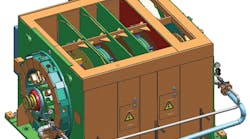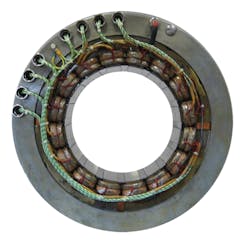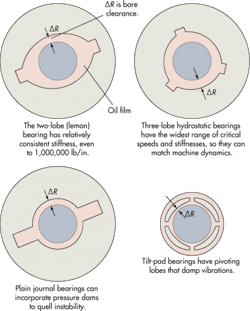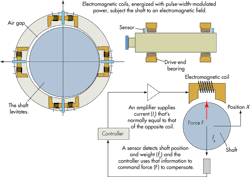High-speed rotating shafts present challenges for engineers, particularly in heavy equipment that draws many megawatts of power. Examples include pumps and compressors for oil-and-gas operations, industrial spindles, and aerospace subsystems. Such machines, which can have shafts that weigh several tons and run at 10,000 rpm or more, are prone to extreme vibrations, excessive heat, and catastrophic failure should any mechanical parts go too far out of alignment.
One option is to eschew the turbines that traditionally power such applications and instead use electric motors paired with variable-frequency drives (VFDs). That’s because some motor-driven setups can reliably deliver power to 15 MW under precise control, with smoother operation and higher efficiency than turbine alternatives. Moreover, they perform particularly well when they incorporate active magnetic bearings (AMBs).
Traditional large-scale designs
Steam and gas turbines are widely used in oil-pipeline compressors, generators, ships, generators, and other heavy equipment. Gas turbines, a type of internal-combustion machine, couple compressor to turbine through a combustion chamber. The compressor draws air and pressurizes it; then fuel disperses through the air and combusts. Resulting hot air then flows through the turbine propeller, where it expands and turns an output shaft. Steam turbines operate the same way but use water instead.
This file type includes high-resolution graphics and schematics when applicable.
Besides running rougher than motor-driven machines, steam and gas turbines have five major drawbacks. They are relatively inefficient, typically around 60% or so. They emit more CO2 per unit of power output than electric designs. Steam and gas turbines need frequent maintenance because their fuel nozzles, exhaust hardware, bearings, seals, and packings are wear components and need regular inspection or replacement. Most consist of specialty drivetrains not widely available. Lack of off-the-shelf availability makes for longer lead times.
Another alternative is to power heavy equipment with high-speed motors and VFDs. An engineer can select a VFD-controlled motor to power a high-speed machine in four basic steps:
- Confirm the location has electrical infrastructure. Then define the machine’s basic design and geometry, and with manufacturer help, select a motor.
- Pick a bearing design to suit the application speed range and rotor dynamics. Two common choices for high-speed heavy equipment are oil-film bearings and AMBs, because bearings with rolling elements are speed limited (from their response to centrifugal forces and tendencies for seal wear and rough running). Also decide whether the application is harsh enough to necessitate bearing shields.
- Ensure that the drivetrain works in the machine’s application-specific footprint to minimize the chance of vibrations, excessive heat, or catastrophic failure from imbalance. Also, electric motors generate heat. They can incorporate air-to-air, air-to-water, or open cooling circuits, depending on whether the environment is dusty or clean and whether air or water supplies are available at the installation site.
- Ask whether the application must meet stringent vibration and noise specifications. Heavy equipment often does. If applicable, ensure the installation satisfies relevant API, IEC, and ISO regulatory codes. Rotor design is key to satisfying this step.
Rotor requirements
Motor rotors in large industrial machinery running at high rpm must withstand significant dynamic forces and material stress. Otherwise, they warp and can cause imbalance, instabilities, and premature motor failure. To prevent such problems, a rotor in a high-speed application, no matter its geometry and final finish, must meet fundamental design requirements:
• The rotor should have low electrical losses as well as low friction losses even at high surface speeds. It should withstand brief periods of overheating, cold starting, and other environmental abuse.
• The shaft should retain its modal properties — including mode shapes (how it undulates, in terms of half waves, along its longitudinal axis), damping ratios, and natural frequencies — over its lifetime.
• The rotor should retain its residual unbalance (uneven distribution of mass around the rotational axis) and resist becoming more unbalanced over its lifetime — mostly by withstanding centrifugal forces.
Software-based analysis and support from the manufacturer can help engineers pick rotors that meet these requirements. It is particularly important to minimize vibration at various speeds in machines with hydrodynamic fluid-film bearings as well as those with AMBs, in which shaft modal parameters partially define closed-loop controls.
Bearing design
Good bearing dynamics also promote machine reliability. Bearings that support the rotor can serve two secondary purposes — to shift the machine’s critical speed away from regular operating speeds and minimize vibrations by damping. (Otherwise, machines need external mechanical dampers.) The goal is to prevent increased vibration, even if the machine temporarily operates at natural frequency.
To this end, high-speed heavy equipment driven by motors often incorporates hydrodynamic fluid-film bearings. A thin lubricating oil film separates a rotating journal and Babbitt layer to prevent metal-to-metal contact. The thickness of the lubricating oil film depends on the geometrical dimensions, radial clearances, speed of rotation, and oil viscosity. The catch: These bearings only satisfy dynamic rotor criteria for specific speed ranges.
The two types of hydrodynamic fluid-film bearings include fixed-geometry designs (including cylindrical, two lobe, three lobe, and four lobe) and adjustable-geometry designs (including tilt-pad bearings). Lobe designs have protrusions on the rotating shaft surface that induce preloads in the oil film. The number and geometry of the lobes affects the bearing stiffness and damping qualities — along with critical-speed modes. But hydrodynamic bearings suffer from fluid-film instabilities at high circumferential speeds when lightly loaded. In contrast, tilt-pad bearings work through journal pads that pivot independently, for shapeable oil-pressure profiles. This, in turn, reduces cross-coupled stiffness responsible for out-of-phase force transmission, oil whirl, and instability.
AMBs, on the other hand, avoid these problems altogether. They levitate shafts with a magnetic field for frictionless shaft rotation. They’re suitable for heavy equipment, but only in environments with readily available electric power.
In fact, that’s why AMBs make the most sense for heavy equipment with electric motors, which must have an electricity source anyway. These bearings consist of an electromagnetic assembly, power amplifiers that supply current to stator electromagnets, and a controller and gap sensor that provide feedback to float and center the rotor in the gap. Sensors measure how much the shaft deviates from the command position. Then controls and power electronics modulate the electromagnetic field to recenter it. AMBs also offer:
- High reliability and uptime, with clean (oil-free) operation
- Variable-speed operation and good positioning — plus controls that integrate into machine architectures
- Resistance to extreme conditions and vibration
- A supply of information to machine diagnostics and condition monitoring (to help end users track machine performance and make improvements).
Among the drawbacks are that AMBs have lower load-carrying capacity than oil-film bearings; lower tolerance to overloads; and the need for backup bearings in case of emergency landings, should the magnetic bearings fail or lose power.
For the latter, backup bearings are either rolling or plain. Plain are most common, but rolling bearings (originally based on those for precision spindles) can support shafts many inches in diameter and keep working even after shafts crash into them. Unlike plain bearings, rolling bearings also wear less. And in emergencies (should the magnetic bearing fail), they can temporarily support the shaft at reduced speed. In contrast, some plain bearings for backup need replacement after just one or two shaft crashes.
Bearing-housing caveats
Housings for large, high-speed motors must satisfy certain requirements to prevent bearing damage.
Bearing housings in the case of AMBs should never support forces from the motor structure, because such forces can subject the bearing to damaging forces and vibration and can degrade sensor accuracy.
Bearings must stay cool. Therefore, housings that rely on fan cooling should provide enough pressure difference between the suction and blower to keep temperature down.
Bearings need secure mounting. Flanged-bearing housings, those with faces that bolt onto the machine frame, give the most reliable support. Machines with hydrodynamic bearings are stiffest if the bearing’s center intersects the plane of the end shield. That’s because this configuration lets rotational forces transfer from the rotor to bearing supports via the oil film without transmitting vibrations. On the other hand, bearing forces at a distance from the end-shield plane make moment forces that can excite end-shield vibration modes. AMBs have no such issues.
AMBs and stator structure
Motors produce torque through electromagnetic rotor-stator coupling, and electromagnetic pulses induce radial-force pulses that can deform the stator structure. The frame that supports the stator also contains the bearing housing and rotor. Therefore, if the housing is improperly designed or not isolated, electromagnetic forces can make the machine vibrate. If the frame mounts on a foundation with poor stiffness or if there’s machine misalignment, it will also transmit vibrations through the drivetrain.
AMBs (and their position sensors) decouple housing dynamics and vibrations. They also decouple the stator-core assembly from the housing by functioning as a low-pass spring suspension that minimizes the influence of second-order (twice the shaft rpm) housing vibrations that can be difficult to completely design out of a machine.
Goodbye turbines, hello motors
Consider the large pumps and compressors used in oil and gas applications as in the three completed phases of the North American Keystone pipeline network. These compressors boost fluid pressure by reducing its volume. Likewise, pumps also increase fluid pressure, often to move it through pipes — though compressors primarily work on compressible gasses, and pumps primarily work to pressurize and move mostly incompressible liquids.
Compressors and pumps in large-scale oil and gas operations run at 5,000 to 15,000 rpm or more in some cases. Though there’s no industry standard, these necessitate special designs, because in this general speed range, shafts and connected drivetrain components are subject to extreme forces. Here, integrated electric drives provide faster and smoother start-ups than traditional turbines — delivering power to 5 to 15 MW, even for turbo-compressor direct-drive applications.
In fact, high-speed motor drives can also replace steam and gas turbines in retrofits to boost efficiency. High-speed compressors and pumps have different load-torque requirements at different speeds (depending on process efficiency and flow requirements), but motors paired with VFDs adapt to changing efficiency and flow requirements, which lowers overall cost of ownership. On retrofits, engineers must customize motors to fit the installation’s footprint. The designer should also work with the manufacturer to tailor the motor electromagnetics to the mode in which the drive will function in the application.







